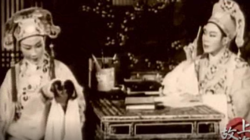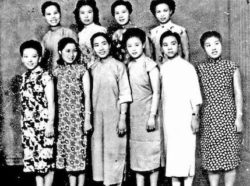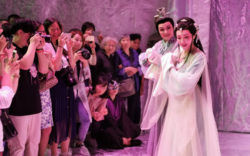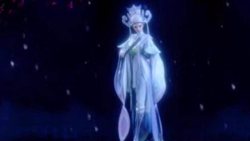Shanghai Yueju
Key to any understanding of Chinese Opera is the acknowledgment that it is not Opera, as associated with ‘high art’ in the Western sense. There are over 300 different regional forms of Chinese Opera in existence today, many having centuries-long evolution, and the majority are associated with rural and migrant community entertainment. Indeed, the term ‘Opera’ was only introduced to describe Chinese theatre in 19th Century America, when it was labelled as Opera to distinguish it from the Americans’ own musical theatre. Although a clear misconception and mislabelling, the use of ‘Opera’ became widespread and is consistently used to this day.
Here we shall examine the short, but extremely rich, history of one specific form of Chinese Opera – Shanghai All-female Yueju. Yue is the ancient name for the Zhejiang region and Ju refers to modern theatre. We shall consider how it formed and developed throughout the 20th Century, becoming the most popular entertainment form across China and how it is currently experimenting and reinventing to attract modern consumers.
Shaoxinxi was the name of a traditional popular community form of singing across the province of Zhejiang, which had derived originally from Buddhist chanting. Farmers and labourers would sing Shaoxinxi whilst they worked and professional actors would perform in tea houses - professional performance was limited to all-male troupes as centuries old Confucian values did not permit women to enter theatres or to perform. The main industry in Zhejiang was the production of silk and related handicrafts and Zhejiang women were nationally reputed as the finest silk workers.
Towards the end of the 19th Century the textile industry in Shanghai was ignited by the mechanisation of textile factories. Western businesses were permitted to trade in Shanghai, as a result of treaties signed following the British Opium Wars and Japanese conflict, and immediately established textile mills and factories to utilise the cheap labour that China had to offer. A rapidly developing textile industry in Shanghai drew labourers from surrounding provinces. Initially the factories took migrant male workers. However, the New Cultural Movement of the 1910s and 1920s focused on female emancipation, seen as the key to breaking the shackles of Confucianism to allow China to modernise. For the first time in Chinese history women became allowed to enter public spaces and take professional positions – which included working in factories and performing in theatres.
The ever-expanding textile industry in Shanghai required an increasing workforce and from the 1920s female migrant workers arrived in Shanghai. The Zhejiang women had suffered, as their silk and handicraft trades had been depleted by the nearby industrialisation, but their skills were highly valued and they were welcomed to Shanghai in their thousands. To entertain themselves whilst operating their mill machinery they took with them their Shaoxinxi and as they received a wage enabling them to consume entertainments, Shaoxinxi troupes entered Shanghai to entertain them.
As women were now able to enter theatre spaces and to perform themselves, an increasing number of female opera troupes formed and in 1923 the first all-female Shaoxinxi troupe performed in Shanghai. Although this troupe created little impression amidst a sea of Shanghai entertainments, it paved the way for further troupes and developed opportunities for continued migration, there being only two career paths for Zhejiang women; to enter the textile mills or to perform Shaoxinxi. By 1925 the increasing number of all-female troupes were being marketed as Shanghai Yueju.

Image - 'Shanghai Story 2014'
The female textile workers formed China’s first ever female working class. They were exclusively migrants from surrounding regions, and whilst popular entertainments from each region had arrived in Shanghai the women sought an entertainment which they could associate with and which, in turn would suit their needs and express their feelings and desires. Shanghai Yueju had smoother tones and musical accompaniment (known as ‘silk and bamboo’) than many other regional forms and soon became the favoured choice of representation for the female textile workers.
Yueju responded by reproducing lyrics, originally written and performed by men for a male audience, presenting females to the centre stage, pursuing love and questioning social inequality and prejudice. An example is found in the ‘Love of the Butterfly’ where the female protagonist Zhu Yingtai disguised herself as a male in order to study, only to fall in love with one of her class mates Liang Shanbo. Star performer Yuan Xuefen recalls the need to change the lyrics which ‘were so shameful to sing, let alone to listen to. Words such as when Liang sings to Zhu: “I will prick my way into your skirt”…I had to delete so many of them and rewrite them’ (Yuan 2002). Reform of all-female yueju transformed women from objective to subjective beings and became the symbol of female rights and female worker solidarity.

The Ten Sisters
This was exemplified in the 1947 ‘Ten Sisters’ charity performance, where ten star performers from different Yueju troupes joined together to produce ‘Love of Mountains and Rivers (Shanhe Lian)’ opposing financial and sexual exploitation by male theatre managers and collecting funds to build their own All-female Yueju theatre.
With its clear links to China’s female working class, the Chinese Communist Party viewed Shanghai All-female Yueju as a key weapon in educating and uniting urban and rural females. CCP rallies and meetings took place exclusively at Yueju performances and underground CCP members worked with performers who were sympathetic to the communist party, encouraging them to create new Yueju to explore social conditions, such as the famous ‘Xianglin Aunty (Xianglin Sao)’, which was based on a novel written by the famous left wing writer Lu Xun, who was later regarded by Mao Zedong as the ‘flag bearer of the CCP’. The story condemned the patriarchal society and women’s repression, and the performance landmarked the start of Yueju and CCP collaboration.
In 1946, after the successful staging of Aunty Xianglin, Zhou Enlai, later the Chinese Premier and Cultural Minister, indicated to the Shanghai underground Communists that they should ‘provide support to this young art form in order to allow this popular opera form to improve its ideological content to influence the audience’ (Ying, 2002: 151). The Chinese Communist Party used regional opera to spread their ideologies to the mainly illiterate urban workers and rural peasants, who formed 90% of the national population, throughout the years of civil war.
Mao saw culture as a vital part of the social machinery, which united and won the hearts and minds of the people (Mackerra 1983: 479). As early as 1942, from the Communist rural based headquarters at Yan’an, Mao delivered his most important speech regarding the role of art: Talks at the Yan’an Forum on Literature and Art, which has been regarded as the ‘Bible’ for CCP views on art. In this speech, Mao stated: ‘There is in fact no such thing as art for art’s sake but art is a consciousness of class struggle, to overthrow the traditional hierarchy, all our literature and art must be for the masses of the people, and in the first place for the workers, peasants and soldiers’ (Kraus, 1976: 1081-1082; quoted in Snow, 1983: 1). Opera’s historical place in mass popular culture was described by Mao Zedong: ‘Those who are literate read books, newspapers and watch plays (Huaju), and those who are illiterate watch operas […]’ (quoted in Mackerras, 1983: 158) and its political use was identified by Zhou Enlai as: ‘having an intimate connection with the masses. Traditional opera is a vital educational weapon on national spirit and patriotism because regional opera is simple in style and lively. It is easy to reflect modern life and easy to be accepted by the audience. Therefore, we should pay special attention to it […] it is important to continue to develop this connection’ (quoted in Ying, 2002: 178). It was opera that was viewed as the main tool to complete the task of building a ‘good society’. The support gained, with the promise of making the workers and peasants the new elites, secured the eventual formation of the Peoples Republic of China in 1949. Amongst the Party and military officials, alongside Mao Zedong, as he declared victory in Peoples Square, were two Yueju performers.
In April 1950, East China Yueju Experimental Troupe was established in Shanghai under the direct patronage of the CCP. In 1954 it was renamed Shanghai Yue Opera House and early yueju reformer Yuan Xuefeng was appointed the first director. By 1956, apart from Yue Opera House, there were 38 state sponsored district Yueju Troupes, four state-private Yueju Troupes and ten private Yueju Troupes registered and performing in Shanghai. In Zhejiang the official state sponsored Troupe was the Zhejiang Provincial Yue Opera Troupe, with a further 80 registered troupes and numerous amateur troupes which moved between Shanghai and Zhejiang.
One result of institutionalisation is the change from traditional Actors’ Theatre to the Director’s Theatre. The Yueju performers had created and improvised, to react to and interact with the audience since its creation, developing what was known as the Actors’ Theatre. Director’s Theatre came from the Soviet Union theatre director Stanislavsky. In 1950, the Minister of Opera Reform, Tian Han, pointed out that ‘In the old society we watch the performer instead of the production. We should not place emphasis on the individuals but the whole team standards of the performance and the entire stage work. This is going to be the key scheme of opera reform and unless we have a director’s system, this part of the reform would not succeed’ (Ying, 2002: 261). Consequently, the Soviet Stanislavsky’s production style, emphasising written scripts, directors, and collectively based long periods of rehearsal, was regarded as more advanced than the Actor’s Theatre and became the only method of official opera production.
Representative Yueju productions created under the collective power of the cultural institutions reached the highest artistic standards and until this day, are still regarded as the classic productions of Shanghai Yueju, including Love of the Butterfly (Liang Zhu) and Dream of the Red Mansion (Honglou Meng). In collaboration with Hong Kong film studios, these productions were made into films and digitally released in mainland China, as well as across East and South Asia, becoming the master pieces of Shanghai Yueju. Although the Director’s Theatre lead to a stagnation of creativity amongst the artists themselves, these script based performances were hugely popular and of high production standards, ever increasing the popularity of Yueju. Throughout the 1950s and early 1960s, Shanghai textile factories had loud speakers playing Love of the Butterfly ‘reunion after long parting from Liang Shanbo (jiubie chongfeng liangshanbo)’ every day. Nearly everyone in China could sing ‘Lin sister has fallen from the sky (tianshang diaoxiage linmeimei)’, an aria from Dream of the Red Mansion (Shanghai Story 2014).
Under Mao, the textile industry and yueju were handpicked to advance gender equality and exemplify socialist progression. ‘Textile female worker’ (fangzhi nvgong) became a new phrase in Shanghai, symbolizing socialist progression. Over 550,000 female textile workers were employed and every household in Shanghai had a family member and/or friends as fangzhi nvgong. Similarly, 113 Shanghai yueju troupes were registered and 4,647 in Zhejiang (Ying 2002: 162). There were organized yueju competitions within textile mills, workers interacting with yueju troupes and all performance tickets were fully subsidized.
In the first CCP five-year plan (1950-1955), Shanghai industries were relocated across the nation for knowledge transfer, along with yueju troupes ‘to ensure the workers will settle’. Between 1956 and 1959, yueju expanded to nearly all of the 23 provinces and 5 autonomous regions across China. By the end of 1965, state owned Yueju troupes across China increased to 175 (Ying 2002: 180-181, 213), becoming China’s second largest opera.
From the beginning of the Cultural Revolution (1966-1976), all opera companies stopped production and went through the most vigorous self-reform and self-criticism. Yueju’s love theme content and the all-female performance-based genre were denounced as most resistive to achieving revolutionary class struggle. Jiang Qing denounced yueju as ‘poisonous bourgeois grass developed in a strange bed of soil’ and referred to yueju as having developed under the decadent influence of foreign concession and other Western cultural phenomena in early twentieth century Shanghai (Gao, 1991: 98). From 1966, all female yueju companies in Zhejiang province closed down. All regional yueju opera companies in Shanghai closed down. Although the SYH still existed, it was not functioning. Instead, all of the SYH artists were sent to the countryside to be re-educated and many endured interrogations.
By the time that the Cultural Revolution finally came to an end in 1976, the SYH was a bureaucratised institution with stagnated production. By the end of Mao’s era, workers and yueju performers’ enthusiasm towards building socialism declined.
Deng Xiaoping’s open door policy in 1978 hailed the motto ‘it does not matter if the cat is white or black so long as it catches mice’ inferring that Capitalist practice could be adopted for socialist ideological achievement. After the crack-down of the 1989 Tiananmen Square event, and three years contemplation, Deng emerged in 1992 to further push Capitalist practice through marketization and SOE reform as the only way to retain CCP legitimacy and survival (Ma 2016). In 1994, under the central call of ‘smashing ten million (old) machines nationally (quanguo yading yibaiwan)’ Shanghai, as the newly made ‘Head of the Dragon’, was to lead post-industrial transition. Before the end of 2000, nearly all Shanghai textile mills were closed down and compulsory redundancy reduced 550,000 female textile workers to less than 15,000.
The housing which the textile workers once occupied was sold to real estate developers and occupants were forced to move to the outlying suburbs where they made do with what little they had (Chen 2009). Meanwhile, theatres were pulled down with symbolic grand theatres erected, one in Pudong and one in Puxi and Shanghai yueju troupes were reduced to just one, Shanghai Yue Opera House, which was put under full marketization with performance tickets sold for between hundreds of pounds to thousands. Many of the redundant textile workers struggled to afford the transportation, from their new suburban homes to the grand inner city theatres, let alone the new ticket prices. From the mid 1990s, the SYH started to make large-scale staff redundancies. National state funding to the opera house was stopped. Instead the central government instructed the regional government to simply fund only the SYH’s staff wage bill. Any other financial needs had to be met through the efforts of the opera house.
The first privately invested production in the SYH was Meilong County in 2000. In 2002, the show won awards in Guilin province and was regarded as ‘youth yueju’ – a much-needed name after decades of yueju stagnation. Annual production increased from the conventional one to two productions a year under the collective system, to approximately three to five per year. By the late 2000s, large productions with extravagance and elegance became seen as the symbol of national identity. This could be seen not only from the yearly increase in scale and style of the Chinese New Year Gala but also in the most spectacular opening ceremony at the Beijing Olympic Games in 2008. Whilst, the larger it is the more successful it is regarded, became a general opinion, the reality was high cost of production and high cost of renting theatre space led to the continued alienation of the traditional audience. Whilst the Grand Theatre performances such as ‘Luxury Style Dream of the Red Mansion’ were intended to appeal to both the traditional audience and the rising urban middle class they missed the mark. The traditional audience finding it not to suit their taste (or finances) whilst the middle class had grown up during the 1960s and 1970s when traditional performances had been stifled and it was unfamiliar to them.
Shanghai All-female Yueju was in need of new impetus and this was initiated by individual performers putting on shows in ‘black box’ theatres across the city and its many university campuses. These proved hugely successful and generated a reconnection with audience. SYH then turned to new media and in 2006 the SYH produced a televised programme, the Yue Girl Competition (Yuenu Zhengfeng), a female only yueju contest with strict criteria for contestants, emphasising youth and beauty. The Yue Girl Competition was an instant success, receiving the highest viewing ratings in Shanghai as well as other cities. The television show itself was just the start of things. Online forums were established to discuss the show and the results. Social media held constant discussions on the individual performances and the decisions by the judges. Huge fan bases formed to support individual performers and, in one instance, the pressure from the supporters caused one judge to resign in tears after daring to criticise one of the favourite young performers - Ms WANG Rousang – who has subsequently gone on to become one of SYH’s lead performers. The popularity of Yueju once again boomed.
Further innovation has followed with experimentation with immersive performance, such as the 2018

Fate of Love 2017 - Shanghai Yue Opera House
production of ‘Fate of Love’, in which the traditional stage was erased and the performers and audience mixed in an enclosed space, and more recently, in April 2020, Shanghai Yueju Opera House pioneered digital streaming, in collaboration with TikTok, and received 1.8 million hits, the highest audience online viewings in Shanghai (Chai 2020). Yueju has even made its presence felt in gaming as the most popular Chinese game ‘Honor of Kings’ has introduced a Yue Opera character, in response to wide media criticism over a lack of cultural content. ‘Shangguan Waner’, based on the classic yueju Love of the Butterfly and modelled on the protagonist Zhu Yingtai who disguised herself as a male in pursuit of study, became the only female game character that is cross-dressing, which is a key characteristic of all-female yueju. In addition to the skin or character creation, opera training sessions were offered to potential consumers free of charge, via the character Shangguan. Within five days of the new character being announced over 64 million orders of the

Holographic Shangguan character
skin were placed online. A holographic performance of Love of the Butterfly, is to be debuted in the near future.
China’s fast Culture and Creative Industries development, with a hunger for digital content, sees Chinese opera, a synthetic art form consisting of literature, music, dance and drama as a rich resource. In 2012, China Cultural Bureau put forwarded Action on Chinese Opera Revitalisation, reinforcing Chinese opera protection and innovation, including strengthening Chinese opera mass communication, promoting Chinese opera in campuses as well as calling for regional government policy and funding support for local story telling through opera. Since Xi Jinping’s inaugural speech in 2014, where he stated ‘China Culture Creative Industries future development anchors in traditional Chinese culture’, further financial and policy support for Chinese Opera Revitalisation has taken place. Over 20 plans were drawn for Action on Chinese Opera Revitalisation, Chinese opera is seen as a new power source in creating and inserting a global Chinese cultural identity.
Over the past one hundred years, yueju has been influenced and disrupted by historical, political, and cultural changes: an all-male folk song at the end of the nineteenth century; the pre-1949 all-female urban opera; an institutionalised national opera in the 1950s and 1960s; its near destruction in the post Cultural Revolution period of the 1970s; a revival in the 1980s and 1990s; and the grand style and Grand Theatre location in the new marketised millennium. Yet, it survived. Yueju, as a grass-roots art, will continue to survive and evolve with the support and devotion of the old and the new on the benches and those in the spotlight – the voice of the people will continue to sing.
To use the above information please quote the following:
Ma H 2021. Song of the Female Textile Workers: UK-China Digital Creativity, funded by UK Arts and Humanities Research Council (2021). https://bridgingthegaps.leeds.ac.uk/ Access date
Reference:
Chen E.Y.I., 2009. Shanghai baby as a Chinese chick-lit: Female empowerment and neoliberal consumerist agency. Asian Journal of Women's Studies, 15(1), pp.54-93.
Gao, Y. 1991. Yueju Historical Talk (Yueju Shihua). Shanghai: Shanghai Culture Publisher.
Mackerras, C. ed. 1983, Chinese Theatre: From Its Origins to the Present Day. Honolulu: University of Hawaii Press.
Ma H. Forthcoming. The Missing ICH in Shanghai CCI. International Journal of Cultural Policy.
Ma H. 2015, Urban Policy and Cultural Capital, the case of Chinese opera. London: Routledge.
Shanghai Story 2014. Aunt Stewardess https://www.youtube.com/watch?v=tT2JPPXbKas. Accessed on 10th October 2020.
Ying, Z. 2002, The Development History of Chinese Yueju (Beijing: China Opera Publisher)
Yuan, X. 2002, The Biography of Yuan Xuefen (Yuan Xuefen Zishu). Shanghai: Shanghai Cishu Publisher.
